Crouton Review: An Elegant, Modern Recipe Manager and Cooking Aid - MacStories
Crouton Review: An Elegant, Modern Recipe Manager and Cooking Aid - MacStories |
- Crouton Review: An Elegant, Modern Recipe Manager and Cooking Aid - MacStories
- Getting pickled: 7 recipes that don't use cucumbers - STLtoday.com
- WHAT'S COOKING? Special recipes bring peach pies to flavor extremes - The Times and Democrat
| Crouton Review: An Elegant, Modern Recipe Manager and Cooking Aid - MacStories Posted: 05 Aug 2020 08:15 AM PDT  One trend that emerged from stay-home orders this year is that many people have spent more time cooking than ever before. Many restaurants have been unable to offer indoor dining, and the lack of a commute as much of society adjusted to work-from-home life provided the opportunity to spend more time in the kitchen. Bread baking became a popular habit, but so did home cooking in general. All of this has brought an influx of new entrants to cooking. I'm not new to cooking, but I've nonetheless found myself in the market for a better solution for recipe management, meal planning, and cooking walkthroughs. The app I've found best suited for my needs is Crouton, from developer Devin Davies. Crouton offers a handful of valuable aids for cooking, but the feature at the center of it all is the app's recipe management system. Once you have recipes stored in the app, you can view those recipes in a well-designed, intuitive format, but you'll also be able to easily assign recipes to your weekly meal plan, add ingredients to your grocery list, or be guided through step-by-step instructions while cooking. To get started adding recipes, there are a few options available: you can create new recipes via manual entry, import recipes from Paprika, or import recipes from the web. I used the Paprika importer my first day with the app and it saved me a lot of time. Since then, my primary method of adding recipes has been via web imports. While there's unfortunately no share extension or action extension to do this directly from Safari, Crouton's web importer is nearly as pain-free an experience. Copy the URL for a recipe you found online to the clipboard, then open Crouton and you'll see a pop-up offering to import that recipe into your collection. You can modify any details you'd like, but in my experience the web importer has done a solid job on every try. Recipes can be sorted into folders you create, otherwise they all live in the default 'All Recipes' folder. One nice touch is that recipes can be stored in multiple folders at once, making it more like a tagging system than a traditional folder approach. It's an important detail since plenty of recipes don't fit neatly into a single category. My two favorite aspects of Crouton are its intuitive modern design for parsing recipes and the ease of adding those recipes to a meal plan. On a recipe's detail screen, everything is neatly organized in a layout that makes sense. Rounded rectangles are used to house each of the different blocks of data available for recipes, such as prep and cook times, the ingredients list, and numbered step-by-step cooking directions. As someone who considers himself barely more than a cooking novice, Crouton's playful aesthetics help make recipes feel more approachable to me. Another thing I appreciate about the recipe detail screen is that it's not over-cluttered with features you may not care about; rather, every feature has been thoughtfully added and fits well into the layout of the page. Those features include the ability to scale a recipe's ingredients for the number of people you're feeding, hit the play button to enter cooking mode and get one instructional step on-screen at a time, tap the shopping cart item to easily add select ingredients to your grocery list, and share the recipe in a variety of formats – the PDF option even lets you customize the document's design and contents. Speaking of cooking mode, the most natural way to cycle through each instructional step is to swipe through them, or use the arrow buttons at the bottom of the screen. But it's worth noting that there's a hands-free mode too on devices featuring the TrueDepth camera system. Developer Devin Davies has implemented a clever way of using the TrueDepth camera's face detection features such that you can wink at your device to have it cycle through cooking steps. A right wink moves to the next step and a left wink moves backwards. So if you can set your compatible iPhone or iPad Pro at a level where it can see your face well, this is a convenient way to keep dirty hands away from your device. You can enable this feature via the eye icon in the top-right corner of cooking mode. Meal planning has a dedicated tab in Crouton's tab bar, and consists of a simple list of current and upcoming days in descending order. Tap a day and you'll see your collection of recipes, sorted into their appropriate folders, for you to choose from. You can add either a single recipe to a day, or multiple recipes to cover not only the main entree but also any sides and/or dessert you plan to prepare. There's nothing innovative about the way any of this works, but there doesn't need to be – its simplicity is its strength. I don't use the grocery function of Crouton, but it's worth noting that it's very easy to add ingredients from your recipes to the in-app Groceries tab, which can also hold grocery items you manually add. The best part is that this tab can be synced with Reminders, so that the contents of your grocery list in reminders is reflected in Crouton as well, and vice versa. Finally, Crouton comes equipped with the sort of system features you would expect from a modern app. Dark mode support enables automatic theme switching, context menus are used throughout the UI, and you can choose from a selection of alternate app icons for your Home screen. Near and dear to my heart, there's an iPad client that supports Split View and Slide Over multitasking, and the app also takes good advantage of the larger display with a two-panel layout. I've found the iPad app especially useful while in the process of cooking, since I can sit the device in Magic Keyboard atop our kitchen island and swipe through cooking directions one page at a time. Crouton makes meal planning easy, provides a beautiful way to store and view your recipes, and plays a key role in the cooking process. I'm not someone who cooks more than once or twice a week, so it's possible that for someone more active in the kitchen there are advanced features missing that I'm unaware of, but I've found that Crouton offers exactly what I need in this type of app. It's modern, keeps things simple in a good way, and offers valuable utility with style. Crouton is a free download on the App Store, with a one-time In-App Purchase available to remove recipe storage limits. |
| Getting pickled: 7 recipes that don't use cucumbers - STLtoday.com Posted: 05 Aug 2020 08:20 AM PDT Everyone sort of assumes it is the chicken. Everyone thinks that the process of pickling was invented as a way of preserving food in a time long before refrigeration, and that people who tried it decided that it tasted great, too. But what if it were the egg? What if someone in that long-ago time dropped a cucumber in a vat of vinegar and salt because he thought it would taste good, and later discovered to his surprise that the liquid also helped to preserve the vegetables? Not that it matters. Pickles are wonderful, and they last a long time. They're the best of both worlds. And they don't have to be cucumbers. A wide variety of vegetables and even fruit can be pickled, with excellent results. Even meat can be pickled, if you have a mind to do it. I don't. I'll do anything for food, but I won't do that. Instead, I made seven kinds of non-cucumber pickles, covering the spectrum of ingredients and styles — sour and sweet, vegetables and fruit and eggs. I even made a Japanese version of sauerkraut which, when you get down to it, is just pickled cabbage. I had one slight drawback in my efforts to be completely diverse in pickles: Three of the varieties I made were flavored with cinnamon and cloves. But what are you going to do? At least they taste good. Let's begin with green beans, which make straightforward, unfussy pickles. In that sense, you can think of them as a skinny version of pickled cucumbers. First, you blanch the green beans; you want them partially cooked, but still crisp. After you have chilled them and put them in sterilized jars, you make a syrup of vinegar, salt and water all simmered together with an assortment of herbs and flavorings. Then you can them by putting the jars and their vacuum-seal lids into a boiling-water bath. That's a standard pickle, and a darned good one. Traditional spiced beets take that same formula and adds a small wrinkle, in the form of the aromatics that they use. Ordinary pickled beets are made with nothing more than vinegar, salt and water (and maybe some red wine if you want to get fancy). But the spiced beets I made also benefit from cinnamon, cloves, allspice and the secret ingredient, star anise. I love pickled beets. I always have. But these spiced beets may be my new go-to for canning. Next, I turned to sweet fruit pickles, and here is what I learned about them: I really, really like sweet fruit pickles. Pickled cherries — call them cerises au vinaigre, if you want — make a delightful snack. Try them with a cheese plate. They are nicely sweet, with just a little hint of the vinegar that makes them pickles. In fact, the pickling liquid has almost twice as much sugar in it as vinegar. The other ingredients? Our now familiar cinnamon stick and cloves. Pickled pears are less like an hors d'oeuvre and more of a dessert. They are sweeter than the cherries, with just a whisper of vinegar for a contrapuntal edge. And the other flavors? Um, a cinnamon stick and cloves, but also allspice. The other three pickles I made are different from the first group in that they are not canned — that is, they are not vacuum-sealed in jars. That means they have to be refrigerated and will not last nearly forever. Picked eggs are kind of a transition from canned pickles to uncanned pickles. Pubs around the world keep a big jar of pickled eggs on the bar and away from a refrigerator. Don't do that. Pickled eggs use a simmered syrup, so the pickling liquid is concentrated. Even so, the eggs are subject to causing botulism if they are stored at room temperature. In the fridge, they will begin to lose their flavor after about three or four months. But only if they last that long. Salt and vinegar are perfect complements to hard-boiled eggs, so pickling them produces egg perfection. I like to add a cooked beet to the pickling liquid, too, which not only turns the eggs a beautiful red but also tempers the sharp (but not unwelcome) flavor of vinegar. Quick Red Onion Pickles are even farther from traditional pickles because the pickling liquid is not concentrated. This fact makes them ready to use almost immediately, though they will taste better after two days. Even in a refrigerator, they can only be kept for up to one month. But only, again, if they last that long. These pickles take red onions and make them more mild while still keeping that nice crispy bite. Add them to your salad or put them on a hamburger or a sandwich. For an extra-good treat, put them on a fried or poached egg. For a forkful of heaven, put them on top of a poached egg on top of a salad. You're welcome. The last pickle I made is as far as you can get from pickled green beans and beets and still be a pickle. Hakusai no Tsukemono — the Japanese version of sauerkraut mentioned earlier — is nothing but Napa cabbage and salt. The salt draws water out of the cabbage, and that water serves as its pickling liquid. Add dried peppers or a pepper spice mix if you want, or even pieces of carrots or — it being Japanese — dried kelp. All it takes is a few days and a few pounds' weight. The result is a delightful, salty snack. That's all you ever need from a pickle. Pickled Green Beans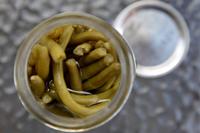 Pickled Green Beans, photographed Wednesday, July 22, 2020. Photo by Hillary Levin, hlevin@post-dispatch.com Yield: 6 pints 3 pounds green beans or yellow wax beans, stem ends removed 2 tablespoons salt, plus more for blanching 6 garlic cloves 6 small dried chile peppers 6 sprigs fresh herbs, such as basil, dill, tarragon, Thai basil or cilantro 3½ cups white-wine vinegar 3½ cups water 1 tablespoon granulated sugar 1 tablespoon yellow mustard seeds 30 black peppercorns 30 coriander seeds 1. Fill a large bowl with ice and water. Blanch the beans in well-salted boiling water (3 tablespoons of salt to 1 gallon of water) for 60 to 90 seconds, until they are bright and pliable but not cooked through. Drain and shock in the ice water. Trim to 4-inch lengths if necessary to fit into pint jars. 2. Divide the garlic, chilies and herbs equally among 6 prepared pint jars. Pack the beans into the jars. 3. Combine the vinegar, water, the 2 tablespoons of salt, sugar, mustard seeds, peppercorns and coriander in a saucepan, and bring to a boil. Ladle the hot syrup over the beans, leaving ½-inch headspace. Seal, and process in a boiling-water bath for 10 minutes. Per serving (based on 12): 82 calories; 1g fat; 1g saturated fat; no cholesterol; 3g protein; 15g carbohydrate; 6g sugar; 5g fiber; 1,182mg sodium; 89mg calcium Recipe from "Saving the Season" by Kevin West Hakusai no Tseukemono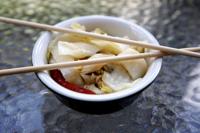 Hakusai no Tsukemono, photographed Wednesday, July 22, 2020. Photo by Hillary Levin, hlevin@post-dispatch.com Yield: 6 cups 4 to 5 pounds napa cabbage (Chinese cabbage) 3 to 4 ounces salt ½ teaspoon to 1 teaspoon togarashi (a Japanese spice blend) or 6 dry red peppers 1. Wash cabbage and discard any discolored leaves. Cut an X in the root end about 3 inches deep and pull the cabbage apart into 4 quarters. Sprinkle each quarter with salt. 2. Place a layer of leaves in a tub, crock or large bowl, sprinkle with more salt and some of the togarashi or a dried pepper. Continue adding layers until all of the cabbage, peppers and salt is used up. Place a plate or disc of wood on top, along with a few pounds' of weight. Cover with cloth and store at room temperature. 3. After 24 hours, the stack of cabbage will have halved in size. Remove the weight and disc, turn the cabbage with your hands and replace the disc and weight. Do not drain the liquid. 4. Let sit for 3 to 4 days. Cut out the hard white core of the cabbage and slice the rest crosswise in 1-inch pieces. Taste, and if it is too salty or hot, rinse as needed with water. 5. The cabbage will continue fermenting, so when it is as sour as you want it, remove from the tub or bowl, drain the excess liquid, and store covered in the refrigerator. Per serving (based on 12): 33 calories; no fat; no saturated fat; no cholesterol; 2g protein; 7g carbohydrate; 3g sugar; 2g fiber; 468mg sodium; 120mg calcium Recipe from "Japanese Country Cookbook" by Russ Rudzinski Traditional Spiced Beets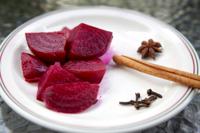 Traditional Spiced Beets, photographed Wednesday, July 22, 2020. Photo by Hillary Levin, hlevin@post-dispatch.com Yield: 4 pints 6 pounds small beets (6 to 8 bunches) 2 cups wine vinegar, white or red 2 cups water 1 cup granulated sugar 1 tablespoons salt 3 inches cinnamon stick 5 whole cloves 5 allspice berries ½ pod star anise 1. Fill a large bowl with ice and water, and set aside. Trim the beet greens to 1 inch above the root, but leave the root's skinny "tail" intact to prevent bleeding. Boil the beets whole in unsalted water until a skewer pierces them easily, 30 to 40 minutes, depending on size. 2. Meanwhile, prepare the vinegar syrup. Combine the vinegar, water, sugar, salt, cinnamon stick, cloves, allspice and star anise in a saucepan, and bring to a boil. Turn off the heat and set aside to steep. 3. When the beets are tender, drain and plunge them into ice water. Slip them out of their skins, tidying up the root and stem ends with a knife as necessary. Cut the beets into quarters and pack them snugly into 4 prepared (clean and sterile) pint jars. 4. Ladle the hot syrup into the jars, straining it through a small, fine-mesh sieve to capture the aromatics. Gently shake the jar as you fill it to settle the beets. Leave ½ inch headspace. Run a skewer or other thin implement around the inside to release air pockets. Seal the jars, and process in a boiling-water bath for 30 minutes. Allow to cure at least a week before opening. Per serving (based on 16): 132 calories; 1g fat; 1g saturated fat; no cholesterol; 3g protein; 30g carbohydrate; 24g sugar; 6g fiber; 575mg sodium; 43mg calcium Recipe from "Saving the Season" by Kevin West Quick Red Onion Pickle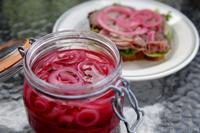 Quick Red Onion Pickles, photographed Wednesday, July 22, 2020. Photo by Hillary Levin, hlevin@post-dispatch.com Yield: 1½ cups 1 medium red onion (about 8 ounces), peeled 3 cups boiling water 1 cup white wine vinegar or apple cider vinegar 1 tablespoon granulated sugar 1 teaspoon fine sea salt 2 teaspoons spices, such as black or pink peppercorns, coriander seeds, cumin seeds or juniper berries, optional 1. Have ready a spotlessly clean 1½-cup glass jar with a tight-fitting lid. 2. Using a sharp knife or mandoline, cut the onion into slices ¹⁄8-inch thick, working your way from stem end to root. Put the onions slices in a colander in the sink, separating the slices into rings. 3. Pour the boiling water over the onion rings. Pack them into the jar. 4. In a small saucepan, combine the vinegar, sugar, salt and spices, if using, and bring to a simmer, stirring to dissolve the sugar and salt. Pour into the jar, tamp down the onion rings so they are fully immersed, and close the lid. Cool on the counter completely before using, 1 to 2 hours (but the flavor will improve over the next 2 days). Store leftovers in the refrigerator up to 1 month. Per serving (based on 4): 37 calories; no fat; no saturated fat; no cholesterol; no protein; 7g carbohydrate; 4g sugar; 1g fiber; 594mg sodium; 21mg calcium Recipe from "Tasting Paris" by Clotilde Dussoulier Pickled Pears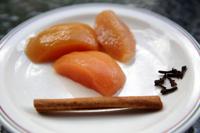 Pickled Pears, photographed Wednesday, July 22, 2020. Photo by Hillary Levin, hlevin@post-dispatch.com Yield: 4 pints 4 cups granulated sugar 2 cups plus 1 tablespoon white vinegar, divided 9 cups water, divided 4 cinnamon sticks, broken in half 1 tablespoon whole cloves 1 tablespoons whole allspice berries 4 pounds firm pears 1 tablespoon salt 1. In a large pot, combine the sugar, 2 cups of the vinegar, 1 cup of the water and cinnamon sticks. Place cloves and allspice in cheesecloth and tie it together or place the spices in a tea strainer or teabag. Add the spices to the mixture, bring to a boil and simmer, covered, about 30 minutes. 2. Pour the remaining 8 cups of cold water into a large bowl and stir in the remaining 1 tablespoon vinegar and salt. Wash and peel the pears; remove the blossom end and cut into quarters or halves. Immediately place the pear pieces into the prepared cold water to prevent browning. Drain just before using. 3. Add pears to the boiling syrup and continue simmering for 20 to 30 minutes. Pack hot pears into clean, hot pint jars; add 1 piece of cinnamon stick per jar and cover with boiling syrup to ½ inch of top. Adjust jar lids. 4. Process in boiling water for 20 minutes (begin counting when the water resumes boiling). Remove jars and tighten seals, if necessary. Store jars upright, several inches apart, on wire rack to cool. Per serving (based on 16 servings): 118 calories; no fat; no saturated fat; no cholesterol; 1g protein; 31g carbohydrate; 24g sugar; 4g fiber; 153mg sodium; 26mg calcium Recipe from "Complete Guide to Home Canning, Preserving and Freezing" by the United States Department of Agriculture Pickled Eggs Pickled Eggs, photographed Wednesday, July 22, 2020. Photo by Hillary Levin, hlevin@post-dispatch.com Yield: 12 servings 1 cup white vinegar 1 cup water 1 tablespoon granulated sugar 1 teaspoon salt 1 teaspoon peppercorns, see note 10 whole cloves, see note 1 bay leaf, see note 2 dried whole chile peppers 1 cooked beet, optional 12 hard boiled eggs, peeled Note: Instead of using peppercorns, cloves, bay leaf and dried peppers, you can use 2 teaspoons of pickling spices. 1. Combine vinegar, water, sugar, salt, peppercorns, cloves, bay leaf and dried peppers (or pickling spices) in small saucepan. Add cooked beet for a beautiful magenta color, if desired. Bring to boil, stirring frequently, until sugar dissolves. Reduce heat to low, cover and simmer for 10 minutes. Strain liquid through sieve or cheesecloth, if desired. 2. Place eggs in a 1-quart jar with lid. Pour hot liquid over eggs. Cover jar with lid. Refrigerate for at least two days before using. Pickled eggs will keep for one month in the refrigerator. Per serving: 88 calories; 5g fat; 2g saturated fat; 186mg cholesterol; 7g protein; 4g carbohydrate; 2g sugar; 1g fiber; 274mg sodium; 39mg calcium Recipe from eggs.ca Pickled Cherries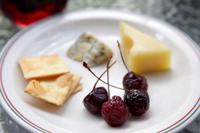 Pickled Cherries, photographed Wednesday, July 22, 2020. Photo by Hillary Levin, hlevin@post-dispatch.com Yield: 3 pints 2½ cups white wine vinegar 4½ cups granulated sugar 1 small cinnamon stick 4 whole cloves 6 cups cherries, about 2 pounds 1. Prepare a boiling-water canner and keep the cleaned jars and lids warm. Heat the vinegar, sugar and spices in a large saucepan, stirring a little to help the sugar dissolve. 2. Prick each cherry with a sharp knife (to prevent them from bursting), but try to keep the stems attached (for looks). Add them to the sweet vinegar and simmer for 4 minutes; do this gently to avoid breaking up the fruit. Lift the cherries with a slotted spoon into warm, dry jars. 3. Remove the spices and boil the vinegar until it becomes syrupy (it will thicken as it cools). Pour this over the cherries, leaving a ½-inch headspace. Use a sterilized plastic spatula to remove any air bubbles. Process the filled jars in a boiling-water canner for 10 minutes. Let cool, tighten the seals again if needed and label before storing. Refrigerate once opened. Per serving (based on 12): 350 calories; no fat; no saturated fat; no cholesterol; 1g protein; 88g carbohydrate; 2g sugar; 2g fiber; 7mg sodium; 20mg calcium Recipe from "Salt Sugar Smoke" by Diana Henry  A weekly treasure trove of tastiness, featuring reviews from restaurant critic Ian Froeb and how-to videos by food writer Dan Neman. |
| WHAT'S COOKING? Special recipes bring peach pies to flavor extremes - The Times and Democrat Posted: 05 Aug 2020 02:00 AM PDT  |

